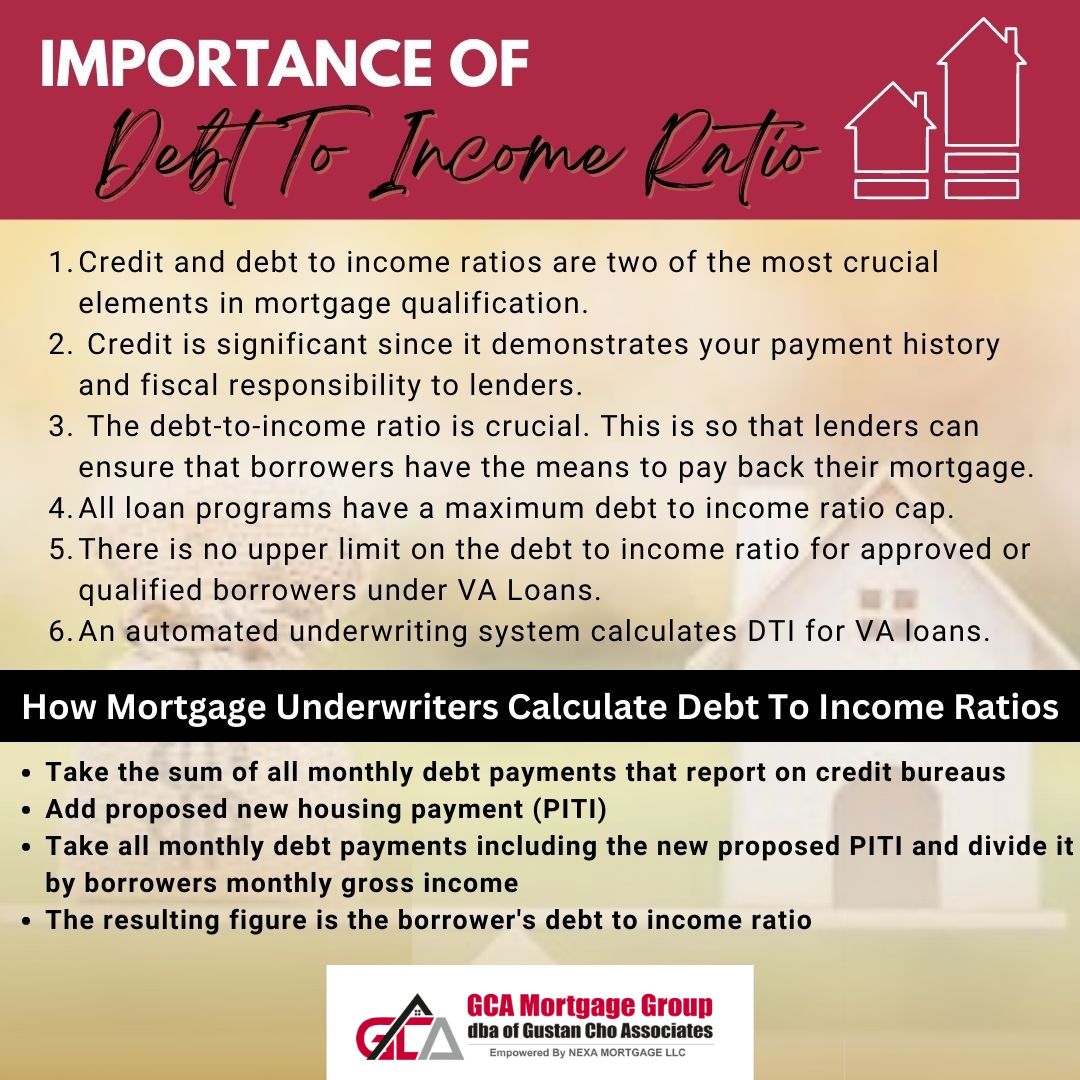FHA Manual Underwriting DTI Guidelines on FHA Loans
In this article, we will cover FHA manual underwriting DTI guidelines on FHA loans. FHA and VA loans are the only two mortgage loan programs that allow manual underwriting on home mortgages. Manual Underwriting is when a human mortgage underwriter will underwrite a file if the file renders a refer/eligible per automated underwriting system. The most noticeable difference between manual and automated underwriting system on FHA and VA loans are the lower debt-to-income ratio cap on manual underwriting.
Mortgage underwriters have underwriter discretion on manual underwrites on FHA and VA loans. One recent manual underwriting VA loan we just closed, the borrower had a 538 credit score and a 64% debt-to-income ratio. It is a manual underwrite and significantly surpassed the 40/50 debt-to-income ratio of the VA and FHA manual underwriting DTI guidelines. But the underwriter used underwriter discretion and approved the file due to strong compensating factors and strong residual income.
How high of a debt-to-income ratio you can go depends on the number of compensating factors you can have. Manual underwriting is key when a borrower is in Chapter 13 Bankruptcy repayment plan and/or just recently got a Chapter 13 Bankruptcy discharged and the discharge has not been seasoned for two years. Manual underwriting is not allowed on conventional loans. In this article, we will discuss and cover the FHA manual underwriting DTI guidelines.
VA and FHA Manual Underwriting DTI Guidelines
VA and FHA are the two government loan programs that allow manual underwriting. Both VA and FHA Manual Underwriting Guidelines are similar. Loan officers take borrower’s application and run credit. They then input borrower’s credit and income profiles to either Fannie Mae or Freddie Mac Automated Underwriting System. Approve/Eligible per AUS is what loan officers hope for. However, borrowers who get a refer/eligible per AUS can still qualify for FHA and/or VA loans via manual underwriting.
Automated Underwriting System Findings
The Automated Underwriting System (AUS) will render the following Approve/Eligible, Refer/Eligible, and Refer/Caution. Approve/Eligible is the key. Lenders with no overlays like Gustan Cho Associates just go off the approve/eligible. If borrowers get an approve/eligible per AUS and can meet all conditions, Gustan Cho Associates are experts in FHA manual underwriting DTI guidelines. Over 20% of all of our loans are FHA and/or VA Manual Underwriting. The key in manual underwriting is borrowers need timely payments on all of their monthly debts for the past 24 months. In this blog, we will cover FHA manual underwriting DTI guidelines on FHA loans.
Struggling to Qualify for a VA or FHA Loan? Manual Underwriting Could Be the Solution!
Contact us today to learn how we can help you navigate manual underwriting and secure your home loan.
How Compensating Factors Affect DTI on Manual Underwriting
Based on FHA manual underwriting DTI guidelines, two of the most important factors when qualifying for a mortgage is credit and debt-to-income ratios. Credit is important because it shows lenders your payment pattern and financial responsibility. Debt-to-income ratio is important. This is because lenders want to make sure borrowers have the ability to repay their mortgage.
FHA and VA loans have the same manual underwriting guidelines. Timely payments in the past twelve months and debt-to-income ratio caps based on the number of compensating factors. However, VA loans have more lenient guidelines than FHA loans. With VA loans, you can get away with just one year of timely payments. HUD requires two years of timely payments on manual underwriting.
There are a maximum debt-to-income ratio caps on all loan programs. VA loans does not have a maximum debt to income ratio on approve/eligible borrowers. DTI on VA loans is determined by an automated underwriting system. Remember, that strict emphasis is placed on timely payments in the past 24 months on manual underwrites.
How Underwriters Calculate Debt-To-Income Ratios
In this section, we will explain how lenders calculate debt-to-income ratios. Take the sum of all monthly debt payments that report on credit bureaus. Add proposed new housing payment (PITI). Take all monthly debt payments including the new proposed PITI and divide it by borrowers monthly gross income. The resulting figure is the borrower’s debt to income ratio.
What Are Compensating Factors on FHA and VA Loans
Compensating Factors are important in manual underwriting. Compensating factors are favorable factors of borrowers. Per HUD and VA manual underwriting guidelines for VA and FHA manual underwriting DTI guidelines, only certain factors can be used as compensating factors. The number one most accepted compensating factor is low payment shock. Low payment shock is when the new PITI or housing payment is the same or not more than 5% higher than the rent the borrower has been paying. Low payment shock is a strong compensating factor. The ability and history of the borrower saving money is a strong compensating factor.
Borrowers who keep on getting certification and going for advanced degrees in his or her field with a history of rising up the rank at their company or place of employment shows the mortgage underwriter strong compensating factor.
The borrower having consistency of getting promoted at his job over a course of time is a compensating factor. For example, a second lieutenant in the Army rising the ranks to colonel or general. Having a second job for at least one year but not using that income to qualify for the current mortgage loan. Substantial reserves of three or more months is a compensating factor. Putting more down payment that the require amount is a compensating factor.
Compensating Factors Determine DTI on Manual Underwriting
Debt-to-income ratios on FHA Manual Underwriting DTI guidelines depends on borrowers compensating factors. FHA Manual Underwriting DTI Guidelines depends on borrowers compensating factors. The only difference between approve/eligible per automated underwriting system files and manual underwriting is the lower DTI cap. Manual underwriting has substantially lower debt-to-income ratio cap than automated underwriting system approved files. Mortgage borrowers with no compensating factors, the maximum front end DTI is 31% front end and 43% back end DTI. Borrowers with one compensating factor, FHA Manual Underwriting DTI Guidelines allow 37% front end and 47% back end DTI. Borrowers with two compensating factors, max front end DTI is 40% and back end DTI is 50%.
Need a VA or FHA Loan with Manual Underwriting? Let’s Get You Approved!
Apply For A Loan That Fits Your Goals
Comparison Between VA versus FHA Manual Underwriting DTI Guidelines
VA loans are more lenient with manual underwriting versus FHA loans. There are instances where borrowers on VA loans can exceed 50% back end DTI on manual underwriting if they have strong compensating factors and strong residual income. It is based on mortgage underwriter discretion, Mortgage underwriters have a lot of underwriter discretion on manual underwrites. Exceptions may be made but that is up to the underwriter’s discretion.
Gustan Cho Associates are mortgage brokers licensed in 48 states including Washington, DC, and Puerto Rico. We have a national reputation of being able to do mortgage loans other lenders cannot do. Over 80% of our borrowers are folks who could not qualify at other mortgage companies due to their lender overlays.
Frequently Asked Questions (FAQs): FHA manual underwriting DTI guidelines on FHA Loans
1. What is manual underwriting for an FHA loan?
Manual underwriting involves reviewing a loan application by a human underwriter rather than having it automatically approved or denied by an automated system. This typically occurs when the borrower doesn’t meet the automated system’s approval criteria but may still qualify based on compensating factors.
2. What are FHA loan Debt-to-Income (DTI) ratio requirements?
The standard DTI ratio for FHA loans is Front-End DTI (Housing Ratio): Typically should not exceed 31% of the borrower’s gross monthly income and Back-End DTI (Total Debt Ratio): Typically should be at most 43% of the borrower’s gross monthly income.
3. What if my DTI ratio exceeds the standard FHA guidelines?
Suppose your DTI ratio exceeds the standard guidelines. In that case, manual underwriting may still allow for approval if there are compensating factors, such as significant cash reserves, minimal increase in housing payment compared to previous rent or mortgage, residual income exceeding requirements, and demonstrated ability to accumulate savings.
4. What compensating factors are considered in manual underwriting?
Compensating factors may include large down payment (10% or more), no significant increase in housing payment, additional income not used in qualifying, minimal or no discretionary debt, and significant cash reserves after closing (3-6 months of mortgage payments).
5. How do compensating factors affect my DTI ratio?
Compensating factors can allow for higher DTI ratios to be accepted during manual underwriting. For example, if you have strong compensating factors, your back-end DTI ratio might be allowed up to 50%.
6. What documentation is required for manual underwriting?
Manual underwriting requires thorough documentation, including verification of income and employment, detailed explanations of any derogatory credit items, proof of assets and reserves, and evidence of rental history or mortgage payments
7. How does manual underwriting differ from automated underwriting?
Manual Underwriting: Involves a human underwriter who reviews the entire application, considers compensating factors, and makes a judgment call.
Automated Underwriting: Uses algorithms and software to quickly assess and approve or deny applications based on pre-set criteria.
8. Can I be eligible if I have a recent bankruptcy or foreclosure?
Yes, but you may need to go through manual underwriting. Typically, you must wait:
Chapter 7 Bankruptcy: 2 years after discharge
Chapter 13 Bankruptcy: 1 year after filing with consistent payment history
Foreclosure: 3 years after the foreclosure sale date
9. What are the benefits of manual underwriting?
Manual underwriting can allow borrowers with unique financial situations to qualify for an FHA loan, especially if they have compensating factors not recognized by automated systems.
10. Are there any additional costs associated with manual underwriting?
There are no specific fees for manual underwriting itself. Still, the process may take longer and require more detailed documentation, potentially leading to higher administrative costs.
11. How can I enhance my possibility of getting approved through manual underwriting?
Ensure all required documentation is complete and accurate. Highlight compensating factors, such as stable employment history or significant cash reserves. Maintain a low level of discretionary debt. Demonstrate a history of timely rent or mortgage payments.
12. Can I still get competitive interest rates with manual underwriting?
Yes, interest rates for FHA loans are typically competitive, even with manual underwriting. However, your overall credit profile, including credit score and other factors, will still influence the final rate offered.
Borrowers who has further questions about FHA manual underwriting DTI guidelines and need to qualify for FHA loans with a mortgage company licensed in multiple states with no lender overlays, please contact us at Gustan Cho Associates at 800-900-8569. Text us for a faster response. Borrowers can email us at gcho@gustancho.com. the team at Gustan Cho Associates is available 7 days a week, evenings, weekends, and holidays.









